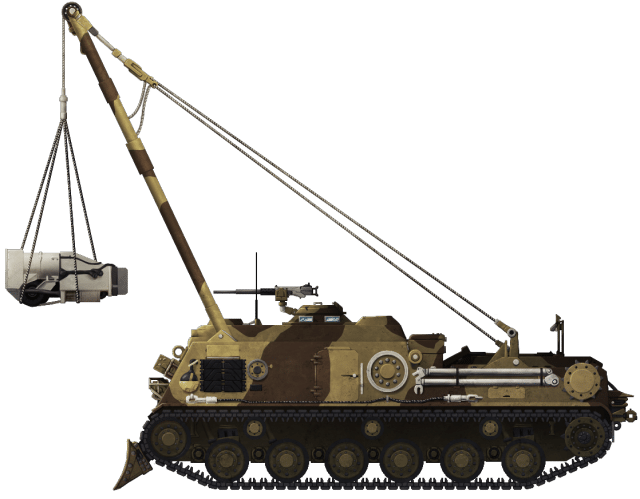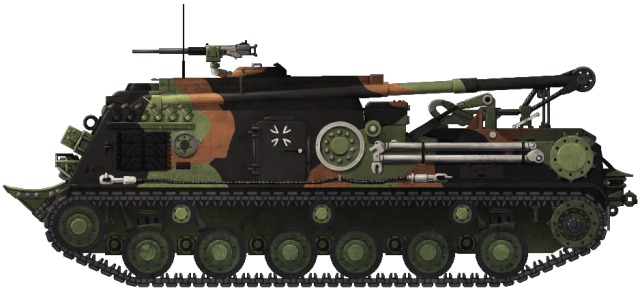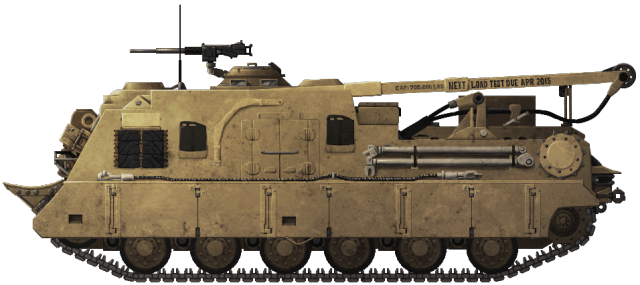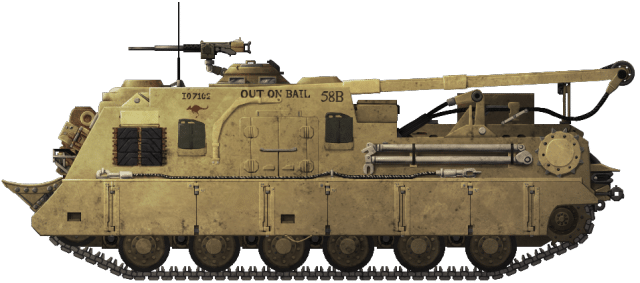
Medium Recovery Vehicle M88
United States of America (1961) Armored Recovery Vehicle – Approximately 3,000 Built
With the advancement of tank technology came the need for a more capable recovery vehicle. The M88 Winch, also known as the Medium Recovery Vehicle M88, was designed to meet this demand. Built to withstand the thicker armor and larger caliber weaponry of tanks and armored vehicles, the M88 Winch became an essential support vehicle.
In response to the US Army’s need for a medium recovery vehicle, Bowen-McLaughlin, Inc. developed a design based on the M48 Patton III. The vehicle, known as the Medium Recovery Vehicle M88, was approved after seven years of development. It entered service in 1961 and remains in use today as the M88A2 HERCULES. This versatile vehicle also serves in the armed forces of various other nations.
After 7 years of development, the finalized vehicle was approved. It would be designated Medium Recovery Vehicle M88. It would enter service in 1961 and through various upgrade programs remains in service with the US Military to this day as the M88A2 ‘Heavy Equipment Recovery Combat Utility Lifting Extraction System’, otherwise known as ‘HERCULES’. The M88 also continues to serve in the armed forces of various other nations, from Australia to Egypt.
Development
In October 1954, the desired characteristics of a ‘medium recovery vehicle’ were outlined by the United States Ordnance Committee. The project received the designation T88, and three pilot vehicles were ordered. In December of that year, a conference was held at the Detroit Arsenal (DA) to review designs for the T88. DA themselves and Bowen-McLaughlin, Inc (BM) put forward designs, two from DA, and one from Bowen-McLaughlin, which was reviewed first.
Concept 1: Bowen-McLaughlin’s design was based on a drastic conversion of the USA’s latest medium tank, the M48 Patton III. The conversion would necessitate the complete removal of the turret and the curved ‘beak’ that formed the bow. This was to provide ample space for a fixed, armored cab to be built at the front end of the hull. Hull extension would also be required to provide enough room for a new, more powerful engine. It was also suggested that the vehicle’s overall width be reduced from the original 12 feet (3.6 meters) to 11 feet 6 inches (3.5 meters). It was hoped that the addition of the narrower 27 inch (68cm) wide tracks of the M47 Patton II would prove sufficient for this. An ‘A’ frame boom forged from tubular steel was placed atop the armored cab capable of supporting 25 tons (23 tonnes). It was also equipped with a 50 ton (45 tonne) capacity winch. It had a single spade stabiliser at the front and two spade stabilisers on the rear that were positioned via cables. The cab would be constructed of 1 inch (25 mm) armor, with a ¾-inch (19 mm) thick roof. The cab would contain the vehicle’s four-man crew.
Concept 2 & 3: DA’s designs were similar to BM’s. They utilized the same basic chassis with a cab at the front and an ‘A’ frame boom mounted atop it. On Concept 2, the cab would have a much lower profile and thinner, ½-inch (12.7 mm) armor. The cab on Concept 3 would be taller and have ¾-inch (19 mm) thick armor. Both designs had a four-man crew, but contained two extra seats for additional personnel. Also, the suspension differed slightly, being a ‘flat-track’ type. This is a suspension without rollers where the track return is supported by the road wheels. Such suspension was used on tanks such as the Soviet T-54. Concepts 2 and 3 were also designed with jettisonable external fuel tanks to increase the ARV’s operational range.
Findings
After considering the three designs, the conference held at Detroit Arsenal concluded that Bowen-McLaughlin’s design had many admirable features. However, doubt was cast over the conversion of the M48 tank. It was thought, as the M48 was the USA’s front line tank at this time, that there would not be enough tanks available for conversion. It was also suggested that it would probably be easier to build a completely new vehicle instead of trying to modify an existing hull. Although an M48-based vehicle was rejected, it was recommended that the T88 be equipped with the features installed on the Bowen design and follow a base tank design to permit maximum interchangeability between them, and standardization of component parts.
The Pacific Car & Foundry Company and the Food Machinery & Chemical Corporation put a spanner in the works by suggesting that all winching and lifting operations be undertaken from the rear of the vehicle. On the BM design, it was done from the front of the vehicle. Mock-ups of the two rear-end focused designs, and Bowen’s front end design were prepared. The mock-ups were reviewed by Continental Army Command (CONARC) who wholeheartedly supported the front end focused vehicle to maximize operator visibility.
After all of these pre-development trials, Bowen-McLaughlin’s design came through on top. In October 1955, authorization was granted for the manufacture of three pilot vehicles. A Contract was signed with BM in April 1956 to start work on constructing the pilots.
A Doomed Project?
A number of delays that arose during the manufacture of the pilot vehicles cast a shadow over the future of the entire T88 project. A meeting held at the Ordnance Tank Automotive Command (OTAC) in January 1957 noted that just 90% of a single vehicle had been constructed. At this time, the biggest threat to the T88 was a new medium tank project that was taking shape to become the USA’s next front line medium tank, the T95. It was suggested that the current T88 design be dropped in favor of a new design utilizing parts from the T95. This would’ve received the designation T88E1.
However, since the M48 was the most numerous tank then in service in the US Military, it was suggested that an interim recovery vehicle be produced by simply making an add-on kit for the M48A2.
The eventual delivery of the T88 pilot vehicles and subsequent tests did not do much to save the future of the recovery vehicle. The vehicles were designed to be powered by the Continental AVI-1790-8 (AVI: Air-cooled, V-configured, Fuel Injected) engine. Producing 580 horsepower, it was thought that the 1790-8 engine would provide enough power to straight-pull the 52 ton (47 tonne) M48 Patton. In tests with the pilot vehicles, however, it was found that it had a relatively mediocre performance. As the weight of tanks was projected to increase over the following years, it was decided to replace this engine with the more powerful AVSI-1790-6 (AVSI: Air-cooled, V-configured, Supercharged, & Fuel Injected.) which produced 690 horsepower. This was coupled with the XT-1400 transmission which was already installed on the M51 Heavy Recovery Vehicle. This was the most powerful propulsion setup available to the Ordnance Department at the time of the tests and a meeting held in October 1958 concluded that it should be installed in the pilot T88s for the remainder of the trials.
Serialisation and Production
In February 1959, approval was granted for the production of three production pilots with the new powertrain. At the same time, the T88 received the official designation and serialization as the ‘Medium Recovery Vehicle M88’.
At this point in time, the T95 had been replaced by the XM60 as America’s future front-line tank. As such, the need for a recovery vehicle in the weight and power-class of the M88 was once more highlighted. The M88’s initial designers, Bowen-McLaughlin, Inc (now known as Bowen-McLaughlin York Company – BMY) were granted a contract in 1960 for the full-scale production of the M88. This contract lasted until 1964, and in that period 1,075 vehicles were produced.
Design of the M88 in Detail
The production model of the M88 is 27 feet 1½ inches (8.27 m) long, 11 feet 3 inches ft (3.43 m) wide, and 10 feet 6 inches ft (3.23 m) tall. A Continental AVSI-1790-6A engine, running through an Allison XT-1400-2 transmission powered the M88. This engine produced 980 horsepower, propelling the 51 ton (46 tonne) recovery vehicle to a top speed of 26 mph (42 km/h). The vehicle consists of an armored cab at the front supported on an elongated M48-like running gear. The vehicle rolls on six road-wheels attached to a torsion-bar suspension with the drive sprocket at the rear and idler at the front. The idler wheel was of the compensating type, meaning it was attached to the closest roadwheel by an actuating arm. When the roadwheel reacts to terrain the idler is pushed out or pulled in, keeping constant track tension. The return of the track was supported by three rollers.
The cab extended back to roughly the center of the chassis, just over the fourth road-wheel. The cab was constructed of 1 inch (25mm) armor on the front and sides, with a ¾-inch (19mm) thick roof. The front plate is slightly sloped backward. There were headlights on the left and right cheeks of the cab. On later models, smoke dischargers were added above these. There are large hatches on the left and right side of the cab, positioned just over the third roadwheel. The A-frame crane arm is attached on pivoting joints at the forward edge of the roof and folds backwards into a travel-lock on the engine deck. At the front of the vehicle is a dozer blade, roughly the same width as the vehicle. Behind the cab is the engine, the fenders of which are part of the same casting as the sides of the cab. This rear section of the vehicle is primarily used for the stowage of spare parts and towing/recovery equipment, pioneer tools, spare road-wheel halves, drive wheel sprockets, rollers, track links and towing bars. As the exhaust pipes from the engine emerged in the center of the engine deck, a cowling system was constructed around them that takes the gasses and smoke, and vents them off the rear of the vehicle. There is a plate under the ventilation grills that deflect the gasses and smoke skywards.
Crew and Their Positions
A four-man crew operates the M88. This consists of the Commander (positioned in the center of the cab), Rigger (behind the Commander), Mechanic (front right) and the Driver (front left). Atop the Commander’s position was a vision cupola. It is here that the vehicle’s only armament can be found; a single Browning M2 .50 Cal (12.7mm) heavy machine gun for defensive purposes. There is a smaller hatch behind the Commander’s was for the Rigger. Both the Driver and Mechanic have vision blocks molded into the upper-front plate. They each have their own hatch, and three vision blocks per-position. The Driver has an extra rotating periscope built into his hatch.
A good deal of equipment is stored within the crew compartment. This included: At least 1 rifle (either M14 or M16), 3x M72 LAW rocket launchers, 2x jerry cans of water, 2x jerry cans of oil, 2x fire extinguishers, 1x bolt cutter, 2x vehicle jacks (one of 11 ton/10 tonne & one of 27 ton/25 tonne capacity), boxes of .50 Cal (12.7mm) ammunition, and 3x toolboxes.
Recovery Equipment
There are three major pieces of recovery equipment present aboard the M88. These are a Winch, an ‘A’ frame boom, and a spade. As a recovery vehicle, the winch – A Pacific Car & Foundry manufactured Type U90B – is the main piece of equipment. The winch drum is located in a compartment below the cab at the front of the vehicle. The cable is around 200 feet (61 meters) long and 1 ⅕ inches (32mm) in diameter. It exits the vehicle via a small port in the front plate of the cab and has a maximum capacity of 45 tons (41 tonnes). There is a roller under the port to reduce wear on the cable. The winch is wound/unwound via a hydraulic motor with a winding speed of 42 feet (12.8 meters) per minute.
Second to this winch, is the ‘A’ frame boom and accompanying hoist winch. The boom consists of tubular steel frame with a hoist at the end. The boom is raised and lowered via hydraulics found on the left and right side of the hull. The boom arm has a forward-reach ranging between 4 feet (1.22 meters) and 8 feet (2.44 meters). At 4 feet of reach, maximum lifting height is 25 feet (7.66 meters), at 8 feet, this is reduced to 22 feet (6.87 meters). Lift is provided via winch and cable. The winch is located below the crew compartment with the cable traveling through a tunnel in the cab and emerges from a porthole the roof. The port is protected by a winch cable access door with integral rollers to reduce wear. The cable, which is 200 feet (61 meters) long and ⅝ of an inch (16mm) in diameter, then stretches up to the pulley at the top. The cable has a maximum capacity of 25 (23 tonnes). When raised, the boom is supported by stayline cables which are anchored on the left and right rear of the engine deck.
With its 45 ton (41 tonne) capacity, the main winch is responsible for the recovery of heavy vehicles such as medium tanks, like the M60 or M48. With roughly half the capacity of the winch, the boom is mostly used for the recovery of lighter wheeled vehicles or light armored vehicles like the M113 Armored Personnel Carrier (APC). It is predominantly used for the hoisting of heavy equipment, such as cannons or mine plows, and automotive components, such as engine and transmission units.
Located at the front of the vehicle, the hydraulically operated dozer blade, also known as the spade, has a number of roles. When the boom crane is deployed and lifting, the spade is utilized in a similar fashion to outriggers on a commercial crane. The blade is lowered underneath the front of the hull so far that the first set of road-wheels are almost touching the back of the blade. The blade is roughly the same width as the hull at 11.25 ft (3.43 m), and can, of course, also be used for light-bulldozer work, such as carving out hull-down positions for tanks, digging gun emplacements, route denial (creating and filling anti-tank ditches), improving bridge approaches, and leveling uneven ground. When not in use, the spade is stored in a horizontal position just above the idler wheels.
The M88 also carries a number of pieces of towing equipment. These include spare pulleys, tow-bars, towing chains and towing cables. This equipment is stowed on the left and right flanks of the engine deck. The M88 has a towing capacity of 45 tons (41 tonnes), and can safely tow at speeds up to 13 mph (21 km/h).
Upgrades and New Models
M88A1
Although the M88’s Continental AVSI-1790-6A engine was powerful, it had a high rate of fuel consumption. A full, 445 gallon (1,684 liters) tank gave the M88 a range of 201 miles (322 km). In the 1960s, the Military began to upgrade their vehicles to have more economical diesel engines. In 1972, BMY received a contract to produce a diesel-powered version of the M88. A prototype was ready by 1973, and it was designated the M88E1. The new engine was the same as the one installed on the M60 tank. This was the Continental AVDS-1790-2DR (AVDS: Air-cooled, V-configured, Diesel, Supercharged), a turbocharged 12-cylinder V engine. This new engine produced 750hp, this was less than the 980hp of the original engine but it granted increased torque and was thus extremely beneficial to straight-pulling and towing operations. It also granted an increased range of 300 miles (483 km). A new, Allison XT-1410-4 transmission was also installed with the engine. A new hydraulic pump was added that allowed the boom and winches to operate should the vehicle’s engine fail. In 1975, the M88E1 was officially serialized as the M88A1. Of the original production of 1,075 vehicles produced by BMY, 878 were built to A1 with production ending in 1982. In 1989, 2,167 new M88A1s were built. The M88A1 entered service with the US military in the late 1980s.
New Tank = More Power
The original purpose of M88, and then M88A1, was to support the M48 and M60 tanks. When these tanks entered service, they had an approximate weight of 45 tons (41 tonnes) each. By the time these vehicles reached their final forms of M48A5 and M60A3, they weighed 49 tons (44 tonnes) and 52 tons (47 tonnes) respectively. This already exceeded the recommended maximum weight capacity of the M88. Then, the M1 Abrams arrived. The M1 Abrams main battle tank – named after the WWII General Creighton Abrams – had a base weight of 54 tons (49 tonnes) and, over its service life, this weight would only increase. It was clear that the M88 and M88A1 would only be grossly over-burdened by the M1. As such, in 1982, a requirement was drafted to produce an improved, more powerful version of the M88.
M88AX
Bowen-McLaughlin-York had foreseen the appearance of heavier tanks and the logistical issues they would cause the M88 and M88A1. In 1982, the company started work on improving the M88A1. The resulting vehicle was designated the M88AX. It received a new AVDS-1790-8DR air-cooled, turbocharged, 12-cylinder V diesel engine which produced 1,050 hp. This was coupled with an Allison XT-1410-5X transmission. Ballast was added to the vehicle to bring its weight up to 59 tons (53 tonnes). From 1985 onwards, the M88AX was put through a series of trials, during which the AX reached a top speed of 35 mph (56 km/h) and was able to tow an M1A1 Abrams at 25 mph (40 km/h). Although it did not enter service, lessons learned were passed on to the next program.
M88A1E1
In 1987, BMY was granted a contract to produce five improved M88A1s, following the outlines of the M88AX. These vehicles were given the designation of M88A1E1 Improved Recovery Vehicle (IRV). Improvements also included a new hoist boom constructed from hollow, square-profile steel beams, replacing the old tubular steel boom. It also included an improved main winch with greater pulling capacity. Running parallel to the A1E1s development was a new Armored Recovery Vehicle based on the M1 Abrams. In summer 1988, trials were held between the M88A1E1 and a prototype M1 ARV. The winner of the trials was the M88, and additional funding was granted to Bowen-McLaughlin-York to allow quick development to production. In 1989 however, the M88A1E1 project was canceled due to budgetary limitations.
M88A2 & M88A2 HERCULES
In October 1991, the program to develop a new version of the ARV was reinstated. BMY was contracted to continue development up to 1993 when the existing prototypes from previous trials were reworked and put through extensive trials. In 1994 BMY was contracted to produce the new vehicle but due to further budget limits, it was decided to upgrade the M88A1 rather than build a whole new vehicle. In 1997, after tests, this new upgraded version of the M88 was designated the M88A2, it shared a few of the features tested on the M88A1E1. It is also known as the M88A2 ‘Heavy Equipment Recovery Combat Utility Lift & Evacuation System’, poetically acronymed as ‘HERCULES’ (this is also known as a ‘Backronym’). The conversion of M88A1 to M88A2 was a joint effort undertaken by United Defense LP (now part of BAE) and Anniston Army Depot.
The M88A2 was far improved over the M88A1 model. It can lift heavier loads with its reinforced 35 ton (31 tonne) capacity hoist boom and can pull heavier loads with its 70 ton (64 tonne) capacity main-winch. The main winch now had a 321 foot (98 meter) long, 1 ⅖ inch (35mm) diameter cable. A new auxiliary winch was added on the front of the vehicle, under the port where the main winch cable emerges. This auxiliary winch has a capacity of 3.3 tons (3 tonnes) with a 654 foot (199) meter cable. The M88A2 is powered by a Continental (now L-3 Propulsion Systems) AVDS-1790-8CR, air-cooled, turbocharged, 1,050 hp, 12-cylinder V diesel engine coupled with an Allison XT-1410-5A transmission. This gave the ARV more brute force power than the previous power pack, but only improved the top speed by 4 mph (6 km/h). As well as automotive and recovery equipment upgrades, the A2 also received armor upgrades. The entire superstructure was covered in an extra layer of armor plate. Huge, one-piece plates were added to the flanks of the vehicle that covered the whole of the cab and sides of the engine compartment. New two-piece hatches were built into these plates to replace the old one-piece hatches of the earlier M88 models. Another plate was added over the front of the cab, with extra small plates placed in front of the Driver and Mechanic’s positions. Finally, the M88A2 was given armored side skirts comprised of eight separate panels, all hinged to allow access to the running gear. The thickness of this armor is unknown, but it is said to be immune to 30mm Armor-Piercing rounds. In some cases, smoke dischargers were added to the front of the vehicle as well.
The M88A2 HERCULES is now the dedicated companion and support vehicle to the M1 Abrams. It entered service in the early 2000s and continues to serve today. Production of the HERCULES continues today. In September 2017, the production of 20 new vehicles was ordered. In December 2017 a total of 775 vehicles were produced and delivered. Another 60 are expected to be delivered between 2018 and 2019, bringing the Army inventory to 835 M88A2 vehicles. Armored Brigade Combat Teams of the National Guard (ABCTs) are also now being equipped with the M88A2 HERCULES. Upon the completion of M88A2 HERCULES production, 237 older M88A1s will remain in use by non-Abrams equipped units.
Future: The M88A3
The M1 Abrams is set to get even heavier in the future with the increased addition of new, heavier modular armor packages. In 2015-2016, BAE Systems began work on a new version of the ARV, designated the M88A3. The vehicle will feature a number of upgrades, including the addition of a seventh road-wheel to increase stability, and hydro-pneumatic suspension that can lock. (Locking the suspension will grant greater stability in lifting operations, a similar system is used on Self-Propelled Guns (SPGs) to help absorb recoil). Currently, on the A2, a member of the crew has to exit the vehicle and place a wooden block behind the rear wheels to achieve the same result. In October 2018, at the AUSA (Association of the United States Army) exhibition of 2018, one of the first prototypes of this vehicle, which was simply a modified A2 featuring the added road wheel, was unveiled. Further upgrades planned for the A3 include the replacement of the A2’s 1,050 hp AVDS-1790-8CR engine with a 1,300 hp Caterpillar liquid-cooled diesel engine, and the installation of a new transmission based on that of the M1 Abrams. This version of the M88 remains in development.
Experimental Off-Shoot: The Counter Obstacle Vehicle (COV)
The ‘Counter Obstacle Vehicle’ or ‘COV’ was an experimental Combat Engineering Vehicle (CEV) based on the hull of the M88. The control cab was completely removed to make way for two digging arms on the left and right side of the vehicle. A large dozer blade that could also be used as a mine plow was added to the front. The vehicle would never go past the prototype phase, with the program canceled in 1986. Developments made in the program were, however, passed on to the M1 Grizzly, a project to build a CEV based on the chassis of the M1 Abrams.
Service
The M88 entered service in 1961, at first just with the M48 Patton equipped units of the US Army. At this point, the US Marine Corps (USMC) was still happy with its M103 based M51 Heavy Recovery Vehicle, and would continue to use them until 1977. To go into detail about every combat situation the M88 found itself in would be an exercise in futility. Simply put, the M88 has served wherever the US Army has been deployed since 1961. We shall explore a few of its more famous deployments in the following sections. Perhaps its longest deployment was in West Germany with US forces. They were issued to all US tank units stationed in the country.
The Vietnam War
Vietnam was the M88’s first combat deployment with the US Army. It proved itself invaluable in the dense, marshy jungles of the war-torn country. Such terrain was a headache for the tanks that easily became stuck. The M88 proved to be a life-line when recovering tanks and vehicles from these sticky situations. They also proved to be extremely useful in field-repair tasks, and in the preparation of terrain with the use of its dozer blade. While the M48 Patton was the main object of the M88s’ attentions, as it was intended, the ARV was also used in the support of lighter vehicles such as the M41 Walker-Bulldog light tank, and the M113 Armored Personel Carrier (APC). In Vietnam, the M88 would serve alongside the M51, its older, heavier cousin – which was still in service with the US Marine Corps – and the Light Recovery Vehicle M578.
The Gulf War
By the 1990s, the newer M88A1 had entered service. At this point, the M48 Patton and M60 tanks had been largely removed from service in the US Army, with the heavier M1 Abrams Main Battle Tank taking its place. The US Marine Corps, however, continued to use the M60. Also, by this point in time, the USMC was now fully equipped with the M88 and M88A1. One of the first combat deployments of the newer model of the M88 was in the Middle East, supporting American forces in Operation Desert Shield, and the following Desert Storm, during the Gulf War of 1990-1991. The Gulf War was the M88’s first deployment in support of the M1 Abrams, as well as the M2 & M3 Bradley Fighting Vehicles.
Bosnia & Kosovo
The next deployments of the M88 would be to southeastern Europe. Between 1992 and 1995, they were deployed with the US contingent taking part in the War in Bosnia. Later, between 1998 and 1999, the M88 supported the armored sections of the US forces deployed to Kosovo during the war. They were also present to support US tank units that remained deployed as part of NATO’s ‘Kosovo Force’ known as ‘KFOR’.
Afghanistan & Iraq
At the beginning of the 21st Century, American forces would once more see deployment in the Middle East. In 2001, the United States invaded Afghanistan in response to the 9/11 terrorist attacks. In 2003, this was followed by the invasion of Iraq. Afghanistan and Iraq was the combat debut of the newly upgraded M88A2 HERCULES in both US Army and USMC service, as the Marine Corps was now fully equipped with the M1 Abrams. The M88A2 did not just support the Abrams in Iraq and Afghanistan; from 2008, it was also the support vehicle of the Abrams-based Assault Breacher Vehicle (ABV). While here, the M88A2s were equipped with the ‘DUKE’ Electronic Countermeasure (ECM) system. This is a jammer that blocks signals to remote explosives or other devices to stop them detonating. Vehicles equipped with this system are identified by thick white antennas attached to the outside of the hull.
Exports & Foreign Service
The M88 was a great export success, seeing service with around 23 countries around the globe. Next to the USA, Egypt is the second-largest user of the M88. The Egyptian Army currently operates 221 M88A1s and 60-70 M88A2s. The M88A1s were second hand, but the A2s however, were manufactured in the US, with final assembly taking place in Egypt.
Germany was the next largest user, operating 125 M88A1s from 1966 to 1992. Here, the M88 received the resignation ‘Bergepanzer 1’. The M88 was a necessary acquisition by Germany as it had a large fleet of M47 and M48 tanks. In 1985, the began upgrading there M88s to A1 standard. They also began upgrading the onboard radios. Vehicles fitted with new SEM25/35 radios were designated the M88A1 GE. Some vehicles were upgraded further with SEM 70/80/90 radios. Other upgrades included the addition of smoke dischargers on the sides of the cab. These were designated M88A1 GE A1s. In 1992, the vehicle was largely replaced by the Leopard 1-based Bergepanzer 2 and Leopard 2-based Bergepanzer 3 Büffel.
The M88 and M88A1 saw long service in Israel, with a number of M88s upgraded to A1 standard. As is common, the Israelis heavily modified their vehicles to keep them up-to-date. In the case of the M88, this included the heavy application of bar and slat armor to protect against RPGs (Rocket-Propelled Grenades) and shaped-charge ordnance. In addition, a large turret constructed from armored panels and bullet-proof glass blocks was installed over the commander’s position. The M88s are set to be retired in the coming years, and will be replaced by the Merkava-based Nemmera ARV.
Other international operators of the M88/M88A1 include Greece (fleet of 95 M88A1s), Pakistan (fleet of 52 M88A1s), Taiwan (fleet of 37 M88A1s), Austria (fleet of 35 M88A1s), Lebanon (fleet of 35 M88A1s), Turkey (fleet of 33 M88A1s), Jordan (fleet of 30 M88A1s), Israel (fleet of 25 vehicles, a mixed fleet of M88A1s and M88s brought to A1 standard), Brazil (fleet of 12 M88A1s), Morocco (fleet of 12 M88A1s), Portugal (fleet of 6 M88A1s), Tunisia (fleet of 6 M88A1s), Bahrain (fleet of 4 M88A1s), Sudan (fleet of 2 M88As), and Spain (1 M88A1).
The only users of the M88A2 HERCULES outside of the United States are Australia (fleet of 13 M88A2s), Egypt (fleet of 221 M88A1s & 60-70 M88A2s), Kuwait (fleet of 14 M88A2s), Iraq (20-30 M88A2s), Saudi Arabia (fleet of 20 M88A2s) and Thailand (fleet of 22 M88A1s & 6 M88A2s).
As Australia operates a fleet of M1A1 AIM Abrams Main Battle Tanks, it was necessary that they procure its intended support vehicle. Between 2004 and 2005, Australia ordered 7 A2s, which began to be delivered in 2007. In 2017, six more vehicles were purchased. As of 2019, the country operates 13 of the ARVs. The majority of the A2s serve with the 1st Armoured Regiment of the 1st Brigade in Darwin, where the largest force of Abrams is based.
In 2010, the Iraqi army requested the purchase and construction of the M88A2 HERCULES for their own use. Starting that year, eight A2s would be delivered with a second batch of eight following in 2012. Starting in 2010, Iraq began to receive a number of M1A1M Abrams as part of military aid, and currently operates around 140 of the tanks. To support these Abrams, a further quantity of M88A2s were also gifted. The Iraqi army currently operates 24 M88A2s.
The latest purchase of the M88 was by the Kingdom of Saudi Arabia who already had a large fleet of 50-60 M88A1s. In 2016, they procured 20 M88A1s and A2s with a plan for the Saudi Arabians to upgrade them to ‘HERCULES’ standard. It remains to be seen as to whether more countries will purchase the M88A2 in the coming years.
Conclusion
As a whole, the M88 is one of the longest-serving Armored Recovery Vehicles (ARVs) in the world and, quite possibly, one of the most successful in history.
During its 58 years of service, systematic upgrades have kept it in place as the backbone and lifeline of the United States military’s armored units. This ARV’s long service life shows no sign of coming to an end anytime soon, as the M88A2 HERCULES continues to provide support for the M1 Abrams until it is replaced by the M88A3. Likewise, the Abrams is projected to fight on for the foreseeable future, and as such will continue to be partnered with the M88A2.
The original Medium Recovery Vehicle M88 in a standard Olive Drab Livery. The standard M88 served with the US military from the late-1960s, to the late-1980s.
M88A1 with A-frame boom raised in lifting position and hoisting an engine unit. The dozer blade is also lowered to provide support. With a new diesel engine, the M88A1 entered service just before the Gulf War, and would serve during the War in the middle east. The camouflage pattern is based on images of M88s from that time.
Bergepanzer M88A1 GE. The German Army fielded the M88 and M88A1 for a number of years, up to 1992 when it started to be replaced by Leopard-based ARVs. Note the smoke dischargers towards the front of the cab.
The M88A2 ‘Heavy Equipment Recovery Combat Utility Lift & Evacuation System’, otherwise known as the ‘HERCULES’, entered service in the early-2000s. It continues to serve today supporting the M1 Abrams. Note the added armor plate to the cab of the vehicle and the armored side skirts. Note also, the two-part door which replaced the original one-piece, and the square bars of the A-frame boom.
M88A2 ‘Out on Bail’ of the Australian 1st Armoured Regiment, 1st Armoured Brigade. Note the red Kangaroo motif on the side of the cab. Australia operates a fleet of M1A1 AIM Abrams, and as such, starting in 2004, began purchasing M88A2s to support them.
These Illustrations were produced by Andrei ‘Octo10’ Kirushkin, funded by our Patreon Campaign.
Specifications (M88, M88A1 & M88A2 HERCULES)
Dimensions (L-W-H) 27 ft 1 0.5 in x 11 ft 3 in x 10 ft 3 in (8.27 x 3.43 x 3.12 meters) Total weight, battle ready M88 & M88A1: 50 tons (50.8 tonnes) M88A2: 62.5 tons (63.5 tonnes) Crew 4 (Commander, Rigger, Mechanic, Driver) Propulsion M88: Continental AVSI-1790-6A, 980 hp M88A1: Continental AVDS-1790-2DR, 750 hp M88A2: L-3 Propulsion Systems AVDS-1790-8CR, 1,050 hp Transmission M88: Allison XT-1400-2 M88A1: Allison XT-1410-4 M88A2: Allison XT-1410-5A Maximum speed M88 & M88A1: 26 mph (42 km/h) M88A2: 30 mph (48 km/h ) Suspensions Torsion bars Range (Fuel) M88 & M88A1: 280 miles (450 km) M88A2: 200 miles (322 km) Armament 1 x Browning .50 Cal. (12.7mm) M2HB Heavy Machine Gun Recovery Equipment M88 & M88A1:45 ton (41 tonne) capacity main winch 25 (23 tonnes) capacity hoist winch 22.5 ton (20 tonnes) capacity A-frame boom Hydraulic Dozer Blade M88A2: 70 ton (64 tonne) capacity main winch 35 ton (31 tonne) capacity A-frame boom 3.3 ton (3 tonne) capacity auxiliary winch Hydraulic Dozer Blade Armor M88 & M88A1: ¾-inch (19mm) – 1 inch (25mm) around the cab. M88A2: As previous, with extra 30mm Ammunition-proof plating Production (All) Aprx. 3000
Sources
R. P. Hunicutt, Patton: A History of the American Main Battle Tank, Volume 1, Presidio Press Carl Schulze, M88 Armored Recovery Vehicle, Tankograd Publishing David Doyle, M88 Armored Recovery Vehicle Walk Around, Squadron/Signal Publications Ralph Zwilling, In Detail/Fast Track #8: M88A2 HERCULES, Tankograd Publishing www.army-technology.com www.inetres.com www.defesanet.com.br www.defense-aerospace.com www.upi.com (1) (2) M88A2 2019 Selected Acquisition Report (PDF) www.janes.com









